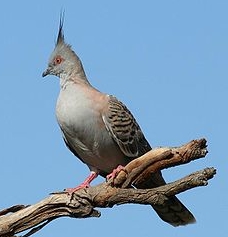It is not just us humans – the humble crested pigeon seems to tell its community about impending danger with a very specialised motor response – a particular wing-flapping (is that phrase allowed?) that broadcasts a warning whistle.

The researchers at Australian National University, in beautiful Canberra (yes – it IS beautiful – I promise), Australia, have shown that although these pigeons always whistle when they take off (I for one have always loved the way they do that), the way in which they whistle is different when danger lurks. Bit of an odd one for Body in Mind to take up, but I thought it a very groovy example of the sophisticated motor system being critical for the communication of danger.
Hingee, M and Magrath, RD (2009) Flights of fear: a mechanical wing whistle sounds the alarm in a flocking bird. Proceedings of the Royal Society (published online before print).
[Crested pigeons] …taking off in alarm fly more quickly or ascend more steeply, so may produce different sounds in alarmed than in routine flight, which then act as reliable cues of alarm…. We show that crested pigeons, Ocyphaps lophotes, which have modified flight feathers, produce distinct wing ‘whistles’ in alarmed flight, and that individuals take off in alarm only after playback of alarmed whistles…. We believe this is the first demonstration that flight noise can send information about alarm, and suggest that take-off noise could provide a cue of alarm in many flocking species, with feather modification evolving specifically to signal alarm in some….



